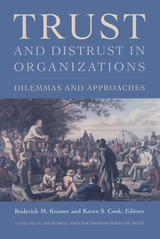7 books about Psychology, Industrial

Discovering Organizational Identity
Dynamics of Relational Attachment
Michael A. Diamond
University of Missouri Press
This book focuses on the theory and practice of understanding and transforming organizations with the goal to discover common ground between groups and individuals. Diamond presents a framework of reflective practice for organizational researchers, scholar-practitioner consultants, executives, managers, and workers in order to promote a more satisfying and humane work-life.
[more]

Emotions at Work
Normative Control, Organizations, and Culture in Japan and America
Aviad E. Raz
Harvard University Press, 2002
Our work life is filled with emotions. How we feel on the job, what we say we feel, and what feelings we display—all these are important aspects of organizational behavior and workplace culture. Rather than focusing on the psychology of personal emotions at work, however, this study concentrates on emotions as role requirements, on workplace emotions that combine the private with the public, the personal with the social, and the authentic with the masked. In this cross-cultural study of "emotion management," the author argues that even though the goals of normative control in factories, offices, and shops may be similar across cultures, organizational structure and the surrounding culture affect how that control is discussed and conceived.
[more]

Managerial Psychology
Managing Behavior in Organizations
Harold J. Leavitt and Homa Bahrami
University of Chicago Press, 1988
The overall structure of this edition is the same as in the past. The book moves from the smaller to the larger. We start with the individual as the focal unit, move to two-person relationships, and onward to issues of leadership, power, small groups, and whole organizations.This edition focuses more than ever on the managing process—on whole organizations and on managing relationships with other organizations. To underline that emphasis, we have included a new section called 'The Manager's Job.' That section deals with what managers do, how they do it, why they do it, and how they should do it.
[more]

Psychodynamics Organization
Larry Hirschorn
Temple University Press, 1993

Readings in Managerial Psychology
Edited by Harold J. Leavitt, Louis R. Pondy, and David M. Boje
University of Chicago Press, 1988
With more than half the papers new to this book, the fourth edition of Readings in Managerial Psychology represents a substantial revision of this popular text. This edition focuses more than ever on the managing process, both within and between organizations, and such "soft" issues as managing creativity and imagination, managers' values and beliefs, and organizational culture play a larger role than they have before.
Readings in Managerial Psychology is designed for managers in business and industry, students of management, public and university administrators, and executives in other organizations. The collection can be used independently or as a companion volume to Harold J. Leavitt and Homa Bahrami's Managerial Psychology: Managing Behavior in Organizations (5th edition, 1988), also published by the University of Chicago Press.
Readings in Managerial Psychology is designed for managers in business and industry, students of management, public and university administrators, and executives in other organizations. The collection can be used independently or as a companion volume to Harold J. Leavitt and Homa Bahrami's Managerial Psychology: Managing Behavior in Organizations (5th edition, 1988), also published by the University of Chicago Press.
[more]

Trust and Distrust In Organizations
Dilemmas and Approaches
Roderick M. Kramer
Russell Sage Foundation, 2004
The effective functioning of a democratic society—including social, business, and political interactions—largely depends on trust. Yet trust remains a fragile and elusive resource in many of the organizations that make up society's building blocks. In their timely volume, Trust and Distrust in Organizations, editors Roderick M. Kramer and Karen S. Cook have compiled the most important research on trust in organizations, illuminating the complex nature of how trust develops, functions, and often is thwarted in organizational settings. With contributions from social psychologists, sociologists, political scientists, economists, and organizational theorists, the volume examines trust and distrust within a variety of settings—from employer-employee and doctor-patient relationships, to geographically dispersed work teams and virtual teams on the internet. Trust and Distrust in Organizations opens with an in-depth examination of hierarchical relationships to determine how trust is established and maintained between people with unequal power. Kurt Dirks and Daniel Skarlicki find that trust between leaders and their followers is established when people perceive a shared background or identity and interact well with their leader. After trust is established, people are willing to assume greater risks and to work harder. In part II, the contributors focus on trust between people in teams and networks. Roxanne Zolin and Pamela Hinds discover that trust is more easily established in geographically dispersed teams when they are able to meet face-to-face initially. Trust and Distrust in Organizations moves on to an examination of how people create and foster trust and of the effects of power and betrayal on trust. Kimberly Elsbach reports that managers achieve trust by demonstrating concern, maintaining open communication, and behaving consistently. The final chapter by Roderick Kramer and Dana Gavrieli includes recently declassified data from secret conversations between President Lyndon Johnson and his advisors that provide a rich window into a leader's struggles with problems of trust and distrust in his administration. Broad in scope, Trust and Distrust in Organizations provides a captivating and insightful look at trust, power, and betrayal, and is essential reading for anyone wishing to understand the underpinnings of trust within a relationship or an organization. A Volume in the Russell Sage Foundation Series on Trust
[more]

Work Better, Live Better
Motivation, Labor, and Management Ideology
David A. Gray
University of Massachusetts Press, 2020
In the United States, a strong work ethic has long been upheld as a necessity, and tributes to motivation abound—from the motivational posters that line the walls of the workplace to the self-help gurus who draw in millions of viewers online. Americans are repeatedly told they can achieve financial success and personal well-being by adopting a motivated attitude toward work. But where did this obsession come from? And whose interests does it serve?
Work Better, Live Better traces the rise of motivational rhetoric in the workplace across the expanse of two world wars, the Great Depression, and the Cold War. Beginning in the early twentieth century, managers recognized that force and coercion—the traditional tools of workplace discipline—inflamed industrial tensions, so they sought more subtle means of enlisting workers' cooperation. David Gray demonstrates how this "motivational project" became a highly orchestrated affair as managers and their allies deployed films, posters, and other media, and drew on the ideas of industrial psychologists and advertising specialists to advance their quests for power at the expense of worker and union interests.
Work Better, Live Better traces the rise of motivational rhetoric in the workplace across the expanse of two world wars, the Great Depression, and the Cold War. Beginning in the early twentieth century, managers recognized that force and coercion—the traditional tools of workplace discipline—inflamed industrial tensions, so they sought more subtle means of enlisting workers' cooperation. David Gray demonstrates how this "motivational project" became a highly orchestrated affair as managers and their allies deployed films, posters, and other media, and drew on the ideas of industrial psychologists and advertising specialists to advance their quests for power at the expense of worker and union interests.
[more]
READERS
Browse our collection.
PUBLISHERS
See BiblioVault's publisher services.
STUDENT SERVICES
Files for college accessibility offices.
UChicago Accessibility Resources
home | accessibility | search | about | contact us
BiblioVault ® 2001 - 2024
The University of Chicago Press









